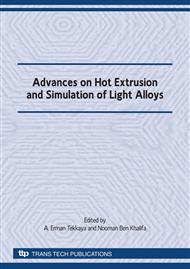p.213
p.221
p.227
p.235
p.241
p.249
p.257
p.265
p.273
Contrasting Models to Determine the Approximate Extrusion Process Conditions for the First Billet
Abstract:
This paper is focused on determining extrusion process conditions for the first billet and, particularly, on selecting an adequate billet temperature and extrusion speed. It is important to predict these values before adjusting the die to avoid lengthy and unproductive preparation times, and to make die adjustment easier during the tests. With that in mind, this study employs two models to determine the first billet temperature (TFB) and the extrusion speed (SE) parameters: one that applies regression techniques and another that uses neural networks. The aim of this paper is to present the results obtained by comparing the performance of the two models to determine which one offers the best results. We also analyze whether changing the number of patterns for construction of the models will improve results. The models are based on extrusion process parameters taken from real industry contexts. The results indicate that the variables chosen as predictor variables for the extrusion speed output must be refined.
Info:
Periodical:
Pages:
249-256
Citation:
Online since:
December 2009
Authors:
Price:
Сopyright:
© 2010 Trans Tech Publications Ltd. All Rights Reserved
Share:
Citation:


